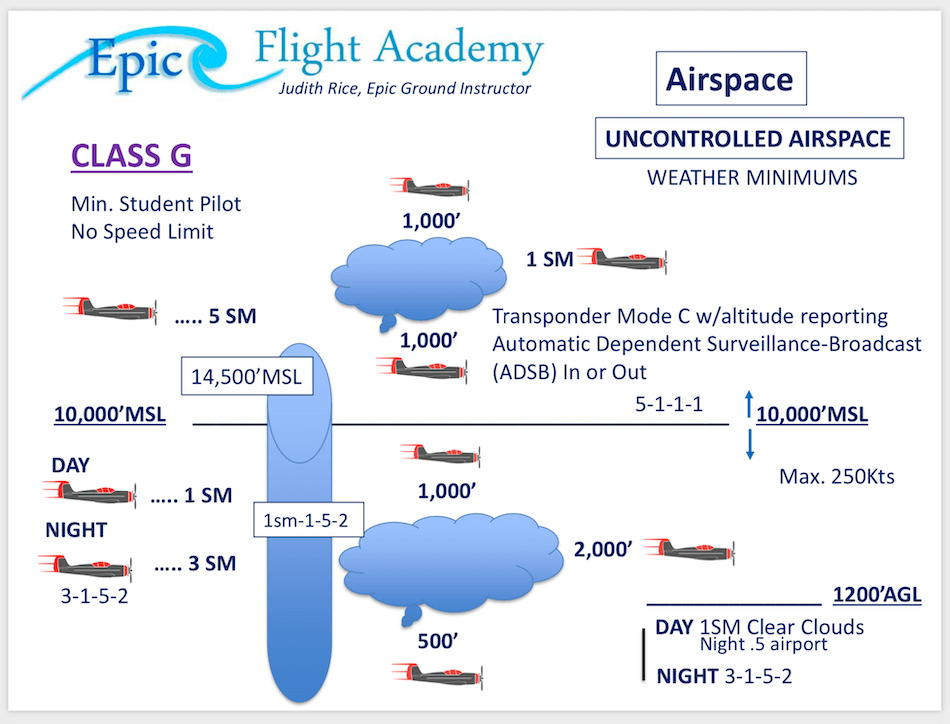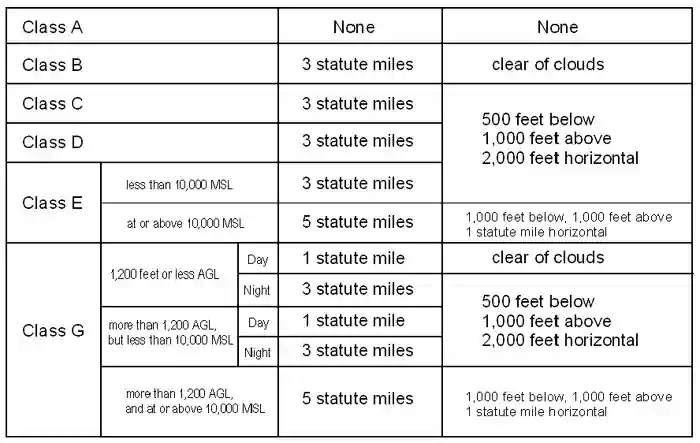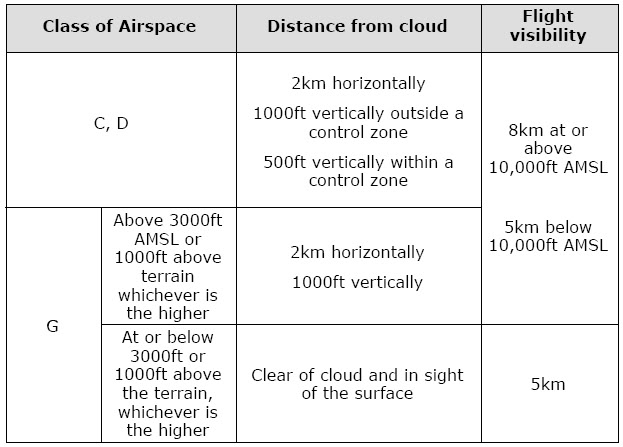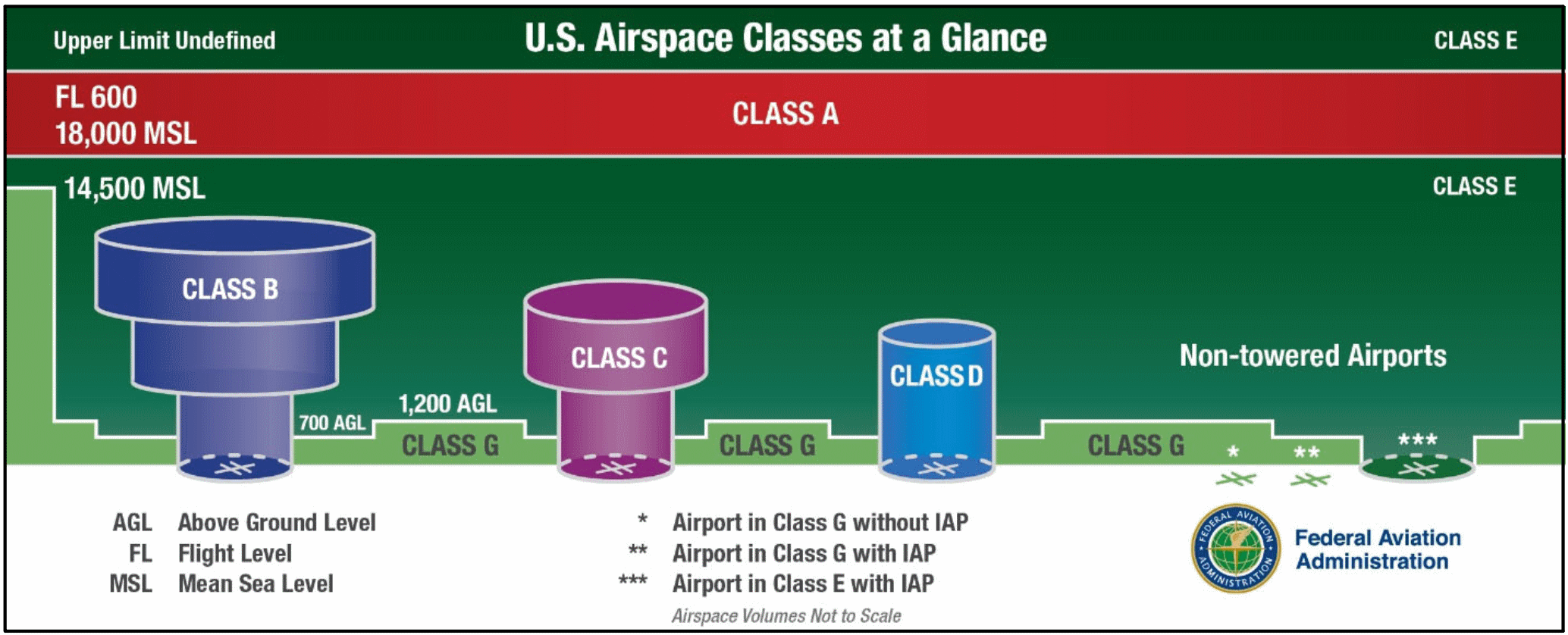class g airspace visibility requirements
36 rows 2 If ground visibility is not reported at that airport unless flight visibility during landing or takeoff or while operating in the traffic pattern is at least 3 statute miles. 1 mile visibility clear of clouds.
For Class B C D and E airspace below an altitude of 10000 MSL the basic VFR weather minimums are.

. Airspace Requirements for Weather Minimums. 1 statute mile visibility and clear of clouds. And its always exclusive.
This line shows enroute Class E airspace starting at. VFR flight is based on the principle of see and avoid The presumption made in establishing the basic VFR weather minimums is that aircraft flying at lower altitudes ie below 10000 MSL andor in airspace. The requirements are slightly less restrictive in Class G airspace with a less restrictive daytime visibility below 10000 feet MSL 1 statute mile only and below 1200 feet AGL by day a less-restrictive separation from clouds clear of clouds with no distance-from-cloud requirements.
At night less than 1200 AGL in Class G airspace the helicopter flight visibility requirements are 1 statue mile visibility and cloud clearance requirements are to remain clear of clouds. Currently helicopters operating in Class G airspace under VFR and less than 1200 feet above the surface are required by 91155 1 to remain clear of clouds and to operate at a speed that gives the pilot adequate opportunity to see any air traffic or obstruction in time to avoid a collision. Because it is uncontrolled there are no communication requirements for Class G and pilots of all ratings are allowed to operate.
Understanding Class G Airspace Private Pilot Online Ground School. A Unless otherwise specified in the certificate holders operations specifications when conducting VFR helicopter air ambulance operations in Class G airspace the weather minimums in the following table apply. Class C Airspace Class D Airspace Class E Airspace Class G Airspace.
Class G airspace uncontrolled is that portion of airspace that has not been designated as Class A Class B Class C Class D or Class E airspace. 1200ft or less above the surface regardless of MSL altitude Day. Class G Airspace Weather Visibility Requirements.
An airspace of defined dimensions extending 3 nautical miles outward from the coast of the United States that contains activity that may be hazardous to non participating aircraft is called. 135609 VFR ceiling and visibility requirements for Class G airspace. However most regulations affecting pilots and aircraft still apply Pilots are reminded that in addition to IFR altitude or flight level requirements FAR 91177 includes the IFR requirement to remain at least 1000 2000 in mountainous.
Basic VFR Weather Minimums. And Class E is more restrictive than Class G airspace. Class G Airspace Daylight Visibility Requirements Above 1200 AGL and below 10000 MSL is.
Flight Rules Pilot Equipment Requirements. Cloud clearances range from clear of clouds to 1SM There are 6 sets of Class G weather minimums associated with various altitudes during the day or night. Although Class G is uncontrolled it is also subject to the most weather restrictions based on where the airspace is located.
Above the Class G ground is Class E everywhere else and is controlled airspace. Class G Is The Most Lenient And Confusing. In Class B airspace aircraft are required to remain.
Here VFR aircraft must maintain higher. For example if Class E starts at 700 feet AGL Class G goes up to but doesnt include 700 feet AGL. On a map Class Gs ceiling is the floor of Class E airspace.
E For the purpose of this section an aircraft operating at the base altitude of a Class E airspace area is considered to be within the airspace directly below. Typically Class G airspace includes all of the airspace below 14500 ft. Minimum flight visibility and distance from clouds.
All operations in Class A Class B Class C and Class D airspace or Class E airspace designated for an airport must receive prior ATC authorization as required in 10317 of this part. 12 rows No person may operate an ultralight vehicle when the flight visibility or distance from clouds is less than that in the table found below. 3 miles visibility 500 below 1000.
Class G Airspace Weather Visibility Requirements. Class G Airspace - Federal Aviation Administration. 6 days ago Class G Airspace.
On the other hand Class G airspace has four different sets of altitude-dependent minimums. Rules governing VFR flight have been adopted to assist the pilot in meeting the responsibility to see and avoid other aircraft. Airspace Flight visibility Distance from clouds.
Except when associated with a temporary control tower ATC does not have responsibility for or authority over aircraft in Class G airspace. For example VFR flights are generally not allowed in Class A airspace so VFR visibility requirements do not exist for that class of airspace. No transponder is required.
Class D airspace is more restrictive than Class E or Class G airspace. Understanding the rationale behind the different requirements might help you remember them more easily. 14 rows Class G airspace will always start at the ground and go up to 14500 MSL as a.
Notwithstanding the provisions of paragraph a of this section the following operations may be conducted in Class G airspace. Class G airspace is most easily found on a sectional map when a fading thick blue line appears. Depending on how high you fly and the time of day within Class G airspace your visibility requirement could range anywhere from 1SM to 5SM.
However within ½ mile of the runway or helipad of intended landing a helicopter may be operated in an airport traffic pattern clear of clouds if the. Above 1200ft stays at 1sm visibility but then for cloud clearance you must be 1000ft above 500ft below and 2000ft horizontal. Of airspace and altitudes.
1 day ago Uncontrolled you do not need to contact ATC to enter or land in Class G airspaceThere are no specific equipment requirementsBasic VFR minimums apply which are 1sm visibility and Clear of Clouds dont fly your airplane into a cloud or let it touch a cloud These minimums cover most Class. That is not otherwise designated Class B C or D airspace. Daytime requirements for Class G are 1 statute mile visibility and clear of clouds to 1200ft.
No person may operate an aircraft under basic VFR when the flight visibility is less or at a distance from clouds that is less than that prescribed for the corresponding altitude and class. Class G airspace uncontrolled is that portion of airspace that has not been designated as Class A Class B Class C Class D or Class E airspaceRules governing VFR flight have been adopted to assist the pilot in meeting the responsibility to see and avoid other aircraft.
What Are The Basic Vfr Minimums Quora
How To Remember Vfr Weather Minimums Bobbie Lind

Faa Airspace For Vfr Flight Youtube

This Is How Class G Airspace Works Boldmethod
What Is The Minimum Visibility For Landing Quora
Powered Parachute Flying Handbook Chapter 8 Airspace Classification And Requirements

Vfr Cloud Clearances Pilot Training For Ga
How To Remember Vfr Weather Minimums Bobbie Lind
How To Remember Vfr Weather Minimums Bobbie Lind
Regulations Vfr Minimums Learn To Fly Blog Asa Aviation Supplies Academics Inc

Airspace Classes And Special Use Airspace Everything There Is To Know





